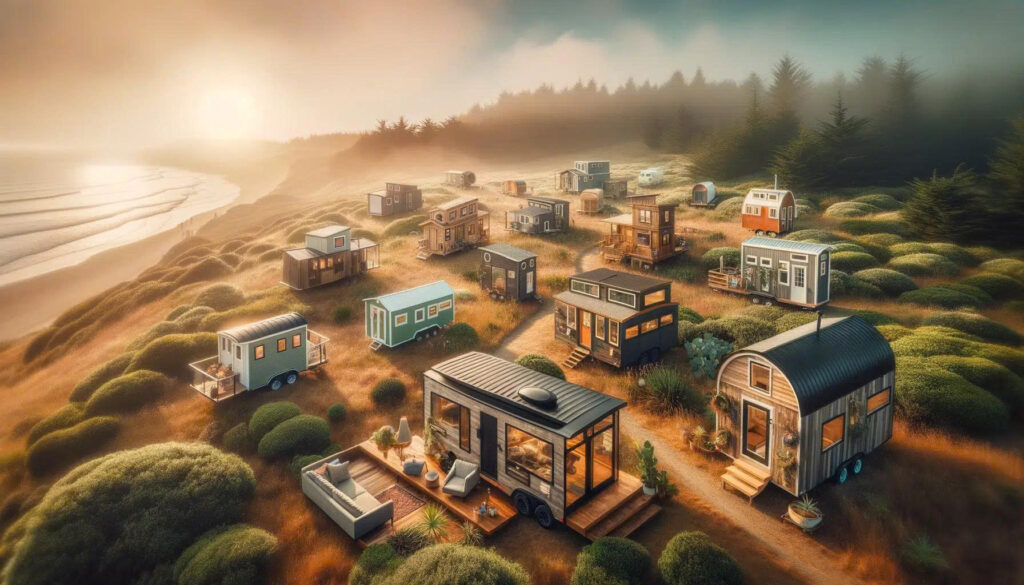
Understanding Tiny House Trailers
A tiny house trailer is the mobile foundation upon which a tiny house is built. Unlike a traditional home, which rests on a concrete foundation, tiny houses on trailers allow homeowners to move their dwelling from place to place.
What Is a Tiny House Trailer?
A tiny house trailer is typically a flatbed trailer designed specifically to accommodate the dimensions, weight, and load distribution of a small home. These trailers vary in size, from 16 to 30 feet long, and are rated to carry loads between 7,000 to 21,000 lbs.
Key Types of Tiny House Trailers
- Deckover Trailer – The flatbed sits above the wheels. Offers more width but less vertical space.
- Drop Axle Trailer – Sits lower to the ground for increased headroom inside the house.
- Gooseneck Trailer – Connects over the bed of a pickup truck; offers split-level living space.
- Bumper Pull Trailer – Attaches to a standard trailer hitch; easier to tow and more common.
Why Tiny House Trailers Matter
Tiny house trailers aren’t just a lifestyle trend; they’re a movement toward freedom, affordability, and sustainability.
The Benefits of Tiny House Living
- Financial Freedom: Building on a trailer saves tens of thousands of dollars in property and construction costs.
- Mobility: Travel across the country or relocate with ease.
- Sustainability: Tiny homes consume fewer resources and promote eco-conscious living.
- Simplicity: Minimalist living leads to less clutter, stress, and maintenance.
According to a 2023 study by the National Association of Home Builders, nearly 63% of millennials consider alternative housing like tiny homes due to financial and environmental motivations.
Common Problems and Challenges
While tiny house trailers offer many advantages, they come with some real-world obstacles.
Zoning and Legal Barriers
- Many cities don’t have zoning codes that accommodate tiny homes on wheels.
- Permits and inspections vary drastically by state and county.
Weight and Load Distribution
- Poor planning can lead to overweight trailers or uneven load distribution, which compromises safety.
- Exceeding the trailer’s Gross Vehicle Weight Rating (GVWR) is a common mistake.
Towing and Mobility
- Not all vehicles can tow a tiny house.
- Navigating tight roads or inclines can be difficult, especially with larger trailers.
Weatherproofing and Insulation
- Exposure to extreme climates requires careful design and material selection.
- Tiny homes must be insulated and ventilated properly to avoid mold or temperature issues.
Practical Strategies for Success
If you’re ready to dive into the tiny house trailer lifestyle, here are essential tips and strategies.
1. Choose the Right Trailer Type
- Evaluate your needs: permanent vs. mobile, solo vs. family.
- Opt for heavier axles and brakes if you plan to move often.
2. Hire an Experienced Builder or Engineer
- Professional builders ensure proper weight distribution and structural integrity.
- DIYers should consult with engineers for critical safety aspects.
3. Understand Local Laws and Codes
- Contact your local municipality for rules on where you can park or live.
- Consider RV parks or tiny house communities with legal status.
4. Design for Lightweight Efficiency
- Use lightweight building materials like SIPs (Structural Insulated Panels).
- Reduce water tanks or heavy appliances if towing often.
5. Prioritize Safety Features
- Install electric brakes and proper lighting.
- Add stabilizing jacks and anti-sway bars for mobility.
A recent article from the Journal of Sustainable Architecture recommends consulting with a certified tiny house consultant during the planning phase to avoid costly mistakes.
Cost and Accessibility Comparison
| Trailer Type | Avg. Cost (USD) | Pros | Cons |
|---|---|---|---|
| Deckover | $4,000–$7,000 | More width, easier construction | Less headroom |
| Drop Axle | $4,500–$8,500 | Lower center of gravity | Slightly more expensive |
| Gooseneck | $6,000–$10,000 | Extra upper-level space | Requires special towing vehicle |
| Bumper Pull | $3,500–$6,500 | Most common, widely accessible | Lower weight capacity |
Low-Cost Options
- Consider used trailers—but always inspect thoroughly.
- Look for regional trailer manufacturers with competitive pricing.
Financing and Support
- Some banks now offer tiny house loans.
- Nonprofits may offer grants for sustainable housing projects.
FAQs About Tiny House Trailers
1. What size trailer is best for a tiny house?
Most tiny homes are built on trailers between 20–26 feet long, offering a balance between space and mobility.
2. Can I legally live in a tiny house trailer full-time?
It depends on your location. Some states allow it under RV laws, while others restrict it.
3. How much weight can a tiny house trailer hold?
Standard trailers can hold between 7,000 to 21,000 lbs. Always consult the trailer’s GVWR.
4. Is it cheaper to build on a trailer than a foundation?
Yes. Building on a trailer often avoids land costs and allows mobility, saving $30,000 or more in some cases.
5. What vehicle do I need to tow a tiny house?
A heavy-duty truck (e.g., Ford F-250 or Ram 3500) is typically required.
6. Do tiny house trailers need insurance?
Yes. Trailer insurance protects your home during transit and may be required by law.
Conclusion
The tiny house trailer is more than just a foundation—it’s a gateway to freedom, sustainability, and simplicity. Whether you’re chasing a nomadic lifestyle or simply want a downsized life, understanding the trailer’s role is crucial. Take your time to plan, research, and invest wisely.
Ready to start your journey? Explore your local zoning laws and begin designing the mobile home of your dreams—your tiny house trailer is waiting.
Disclaimer
This content is for informational purposes only. Always consult certified professionals before making construction or financial decisions.
Source:
- Tiny Home Builders – Trailer Buying Guide
- The Tiny Life – How to Choose a Trailer
- United Tiny House Association
- Inhabitat – Building Tiny Houses
